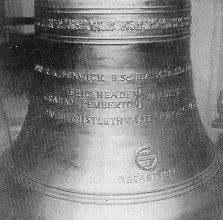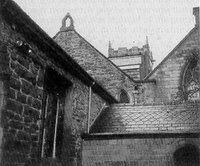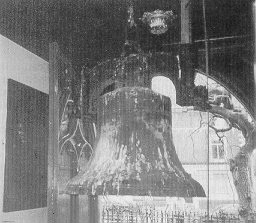St Laurence’s Bell Ringers
We have a fine ring of bells under the direction of our Captain of the Tower. Bell ringing is a healthy, musically satisfying and enjoyable hobby. If you are interested in joining the team please ask our Parish Administrator for details.
The Middle Ages and the Reformation
The first reference to a Church in Chorley is in 1362. We do not know what this building looked like (though parts of it survive in the present Church), but it is almost certain to have at least one bell to summon the people to worship.
There was also a small scaring bell, which was rung at particular solemn moments of the Eucharist. This bell hung from a small arch over the chancel which still survives to this day.
The present Tower seems to be rather younger than the original Church
Certainly, by 1552, the Church had ‘three Greater belles’. These were listed in the inventory of Church Goods made that year by King Edward VI’s Commissioners when they visited Chorley. One or more of these three bells may have been installed when the Tower was first built, only 150 years before.
Five years earlier, in the summer of 1547, a set of Injunctions had been issued in the name of the new King, the son of Henry VIII. The purpose of these Injunctions was to see that all Churches conformed to the new requirements for worship commanded following the break from Rome. One of these injunctions forbade the ringing of bells during the service “except one bell

David Thistlethwaite





The 17th Century – the first recorded recasting
By the middle of the next century, what was probably the surviving bell was itself in need of attention. It was decided to break it up, add more metal and recast it. The following entry from the Parish Register tells what happens.
Decimal quarto Decembrist 1646
Weighed at Chorley the Great Bell who by our Weights cometh to 7701i, being broken in 43 pieces the same metal was cast at Witan By Geoffrey Scott, to who was added 5 score pounds of new metal, at the price of 8d (err) 1i, who makes the whole weight to be 8631i, and pd to the ballooner, for casting 81i, &for metal added 31i-15 which all is xi1i-xvs (£11-15s)





The 18th and 19th Century – the ring enlarged
By the 18th
I
Each time the bells have been recast
The 19th century saw the ring of bells enlarged still further. One new bell was added in 1832 and another in 1860. The second of these was cast by George Mears & Co of
Tenor 10 cwt (approx) G
V 7½ cwt A
IV 6 cwt B
III 5 cwt C
II 4½ cwt D
Treble 4 cwt 7 lbs E
As the accompanying photograph of the ringers in 1875 shows, the bells at this time were rung from ground level in the West
These six bells were rehung in 1883, and the fittings in the tower renewed. It may be at this time that an original wooden frame was replaced by the present metal frame. A plaque in the ringing chamber commemorates this refit:
Ad
These six bells were by subscription rehung with entirely new fittings in the year of our Lord 1883, and reopened on the 15th day of November 1883, when a true peel of Plain Bob Minor, 720 changes were rung in 25¾ minutes by the following ringers:
1.John Hy Gartside, Conductor; 2. William Heaps; 3. John Marsden; 4. Alfred Whalley; 5. George Gartside; 6. Joshua Worthington.
Rector: Edward G. James
Wardens: Henry Rawcliffe and William Bamber







The 1996 Recasting
Over the next 40 years various minor repairs were carried out, untill in 1995 two further reports were commissioned. These concluded:
“Tonally … they are disappointing. The Tenor is quite good, the 6th 5th and 4th are fair, the three smaller bells become progressively ‘wild’ towards the treble end, and the 7th is conspicuously poor.:
“… the bells are very harsh and discordant with the tonal quality of the peal being far below the standard which one would expect for a Parish Church setting.”
The smaller bells in particular were described as “hard, harsh and stifled.” Nor did the tuning of the bells match up exactly with the founder’s specifications. The frame and fittings were, however, found to be in generally good order and, with some repair and cleaning, were reused in the 1996 refit.
Happily, on this occasion, thanks to the generosity of Kathleen Norris, the resources were available to undertake the recasting of all eight bells.
The Parish Church Council approved the project as desirable in itself and as a fitting memorial to Mrs. Norris The Diocesan Advisory Committee also gave its approval and the Rector and Wardens petitioned for a faculty which was granted by the Worshipful John Bullimore, Chancellor of the Diocese of Blackburn on 13th February 1996.
The work was awarded to John Taylor Bellfounders, with whom the Parish had dealt for over half a century, the quote price being £37,475.00




Over the preceding weeks the moulds had been prepared and buried in the foundry sand pit. The actual casting took place on Friday 17th May 1996. A coach load of parishioners travelled down to Loughborough to watch the dramatic process.
Once cooled, the bells were transferred to the tuning shop and tuned as an octave on a 19th century vertical lathe. Towards the end of this process a second coach load of parishioners visited the foundry on Saturday 22nd June, and thus were the first to hear the sound of the recast bells.
The bells were returned to Chorley on Friday 30th August and placed in the body of the Church for their consecration by the Bishop of Blackburn in the context of the Parish Eucharist on Sunday 8th September.
Their specifications were as follows:
Size Weight Note
No 1 2′ 0½” 3-2-14 F#
No 2 2′ 1″ 3-3-0 E
No 3 2′ 2½” 4-0-21 D#
No 4 2′ 4″ 4-3-0 C#
No 5 2′ 6½” 5-2-0 B
No 6 2′ 8½ 6-2-0 A#
No 7 3′ 0″ 8-2-7 G#
No 8 3′ 4½ 12-3-0 F#
As well as the various inscriptions, the bells were all decorated on the shoulder with the vine-leaf motif shown below.





© St Laurence's Church, Chorley 2021 | Designed by Steffany | Privacy Policy
